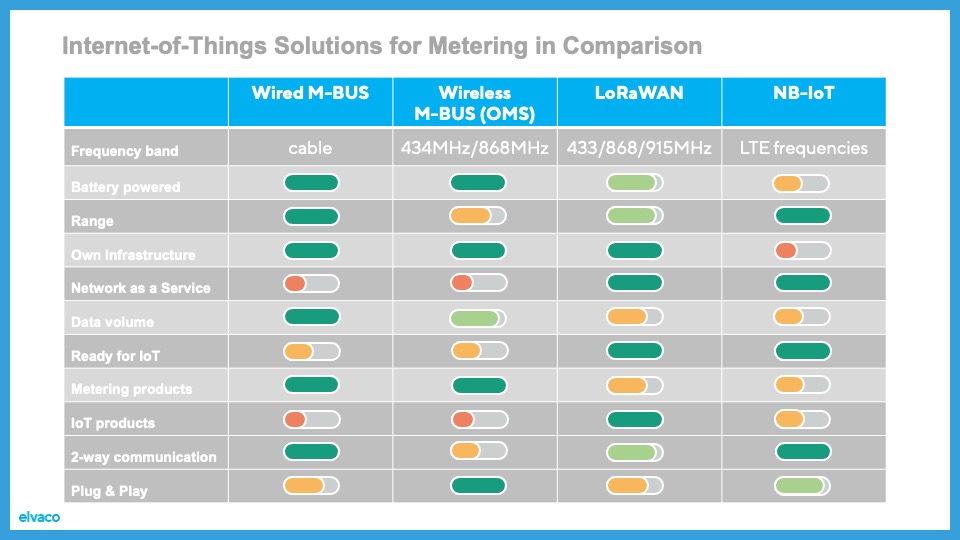Technology Openness – the Matrix for Technology Choice

Every metering or IoT application needs one or more technologies. Elvaco always selects the technology that best suits the project.
In our daily work, it is always a matter of finding the right technology for the realization of an IoT application in metering. Our technology selection matrix provides an overview of the strengths and weaknesses of our four main technologies and allows for a quick, direct comparison according to various criteria.
In this blog post, we would like to introduce you to the advantages of M-Bus, Wireless M-Bus, LoRaWAN and NB-IoT and explain what role the principle of technology openness plays in selecting the right technology.
The principle of openness to technology at Elvaco
By the term technology openness, we mean the procedure that always selects the technology that is best suited for the specific application when choosing technology. In this way, we ensure that IoT infrastructures always function optimally and are not tied to specific technologies that may be outdated or inadequate. We use the following technologies to implement IoT applications such as remote meter reading, smart metering, and other areas of building automation:
- M-Bus
- Wireless M-Bus
- OMS (Open Metering System)
- LoRaWAN (Long Range Wide Area Network)
- NB-IoT (Narrowband IoT)
Technology openness is particularly close to Elvaco's heart, because the principle gives us as a provider and you as a customer the flexibility to adapt to changing requirements and conditions.
Expert tip: Last but not least, technology openness can also improve interoperability between different systems by interlocking different technologies and working together effectively.
From M-Bus to NB-IoT – a comparison of technologies
M-Bus is a wired communication technology, that operates with a long battery life. The high range and robust bidirectional communication enable reliable and continuous data collection. The M-Bus protocol is designed for a large amount of data and offers many products for metering and remote meter reading.
The Wireless M-Bus (wM-Bus) uses the 868 MHz or 434 MHz frequency band in Europe and is also powered by batteries. It offers high amounts of data and a simple infrastructure. The range is lower compared to other technologies such as M-Bus.
LoRaWAN uses the 433/868/915 MHz frequency band and offers a long range and penetration capability combined with a long-lasting battery supply. It enables fast and secure transmission of data and offers excellent compatibility with metering and IoT products. However, compared to other technologies such as M-Bus, it offers lower data transmission.
NB-IoT also offers a high reach as well as penetration capability. However, unlike the other technologies, the LTE-based transmission protocol does not have its own infrastructure. Mobile network operators can offer Network-as-a-Service and it also supports two-way communication. Compared to other technologies such as M-Bus, it also transmits the least amount of data.
Conclusion
Every application in the field of smart metering or the Internet of Things (IoT) requires a competent choice of technology. M-Bus, Wireless M-Bus, LoRaWAN and NB-IoT each offer clear advantages and disadvantages, which should be carefully weighed against each other in the planning process. Thanks to a certain openness to technology, Elvaco has been successfully advising customers for decades on all aspects of choosing the right technologies to build smart infrastructures. We also recommend and sell the right products for specific technologies. If you would like a no-obligation consultation, please do not hesitate to contact our team of experts.
FAQ – frequently asked questions about technology choice and technology openness
What does technology openness mean?
Technology openness means that a system or platform is not tied to a specific technology, but can integrate and use different technologies. It thus enables a more flexible and adaptable environment in which different devices and applications can work together.
Which IoT technology is the best?
The question of which IoT technology is the best cannot be answered in a general way, but only by considering the respective use case. While M-Bus and Wireless M-Bus are ideally suited for metering applications such as remote meter reading thanks to their extremely long battery life and a high amount of data, LoRaWAN and NB-IoT are particularly suitable for IoT applications thanks to their long range and network-as-a-service concept.



